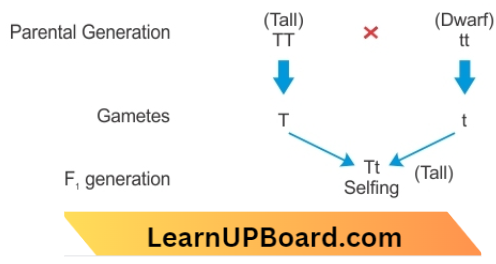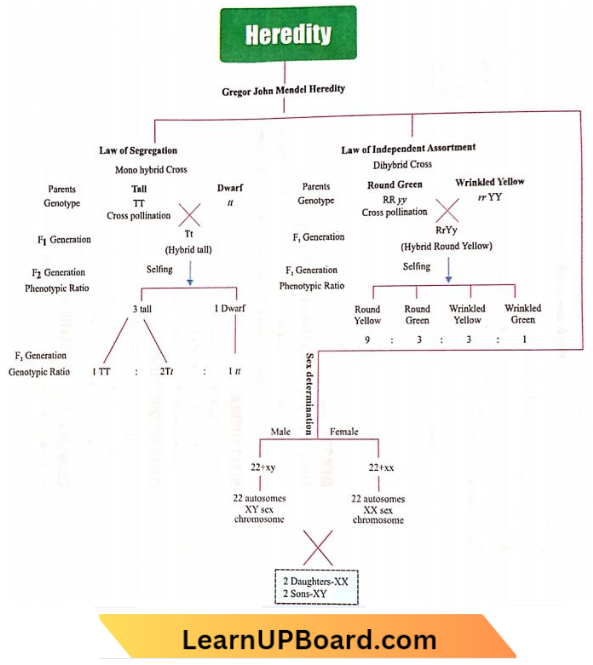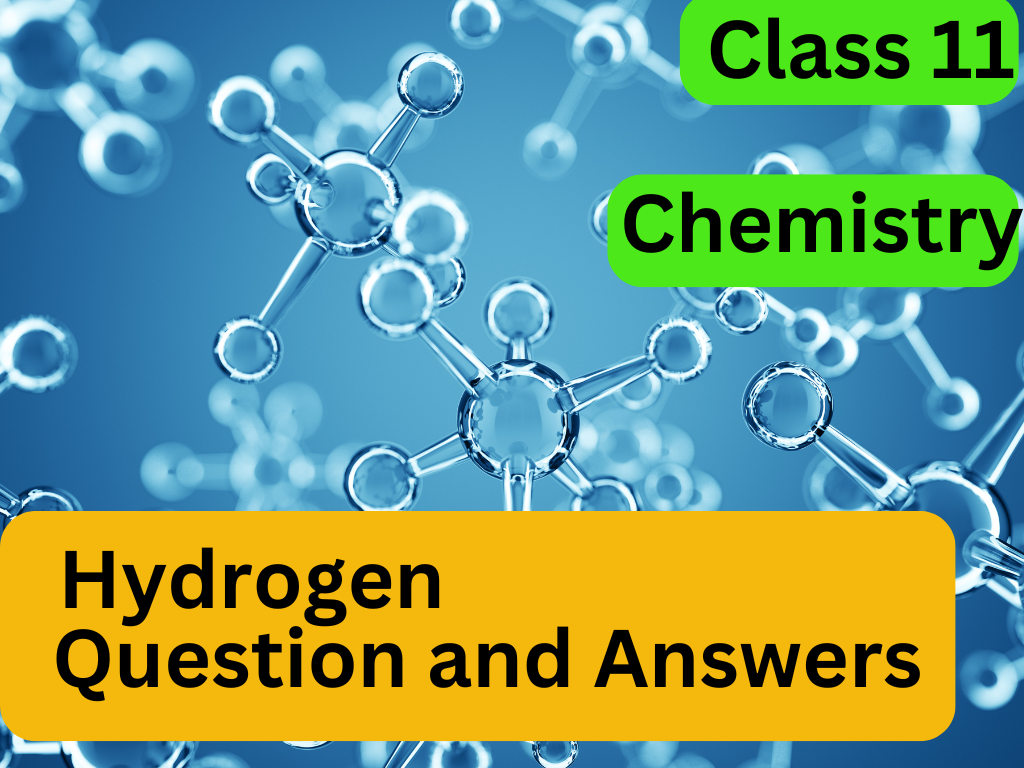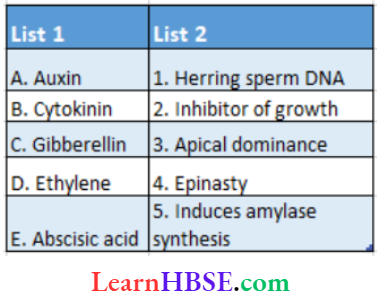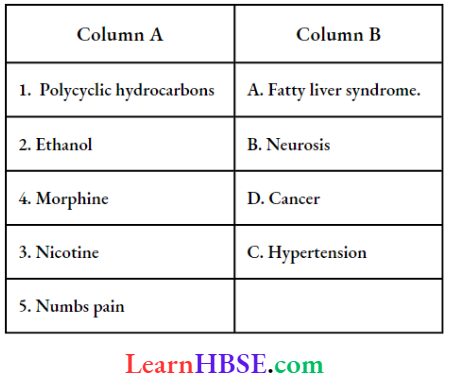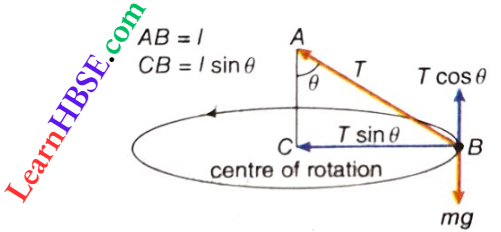Question 1. Discuss whether the difference between the heat of the reaction at constant pressure and constant volume will depend on the temperature of the following reaction.
Answer:
2CO(g) + O2(g)→+2CO2(g)
We know, AH = AU+AnRT
For the given reaction, An = 2-(2 + 1) = -1
ΔH-ΔU = ΔnRT = -RT
So, the value of (ΔH-ΔU) depends on the temperature.
Question 2. Calculate the change in internal energy of the gas when it expands from 2L to 8L at a constant pressure of 2 atm absorbing 400 J of heat in the process. (1 L-atm = 101.35 J)
Answer:
We know, w = -Pex (V2-V1)
∴ ω=_2(8- 2)=-12 L.atm=-12 x 101.3 J =-1215.6 J.
According to the 1st law of thermodynamics, A U=q + ω
Given that q = 400 J
∴ ΔU= (400- 1215.6)J = -815.61
∴ Change in internal energy of the gas =-815.61.
thermodynamics class11 chemistry
Question 3. At 25 °C the standard heat of formation of liquid H20 is -286.0 kJ mol-1. Calculate the change in standard internal energy for this formation reaction.
Answer:
Formation reaction of \(\mathrm{H}_2 \mathrm{O}(l): \mathrm{H}_2(\mathrm{~g})+\frac{1}{2} \mathrm{O}_2(\mathrm{~g}) \rightarrow \mathrm{H}_2 \mathrm{O}(l)\)
For this rections \(\Delta n=0-\left(1+\frac{1}{2}\right)=-\frac{3}{2} \text {. }\)
We know, ΔH° = ΔU° + ΔnRT
∴ \(-286.0 \mathrm{~kJ}=\Delta U^0+\left(-\frac{3}{2}\right) \times 8.314 \times 10^{-3} \times(273+25) \mathrm{kJ}\)
or, ΔU° = -282.28 kj
Therefore, the change in internal energy for the formation reaction of H20(/) is -282.28 kJ.
Question 4. The temperature of 4 mol of a gas decreases from 40°C to -60 °C on adiabatic reversible expansion. The molar-specific heat of the gas at a constant volume being 12 J.K-1 mol-1, determines the change in internal energy and work done in this process
Answer:
For an adiabatic expansion
\(w=\Delta U=n C_{V, m}\left(T_2-T_1\right)\left[T_2<T_1\right]\)∴ ΔU = 4 X 12 X (213- 313) J = -4.8 kj and w = Δt = -4.8 kj
∴ In the process, the change in internal energy = -4.8 kJ, and the amount of work done = 4.8 kJ.
Question 5. Write the thermodynamic relation generally used to predict whether a reaction is spontaneous or not For exothermic and endothermic reactions with their change in entropies being positive and independent of temperature variations, comment on the spontaneity of the reactions in both cases for temperature variations. Compute ΔH° at 298 K for: OH(g)→+H(g) + O(g)
Answer:
The thermodynamic relation that is generally used to predict the spontaneity of a reaction is AG = AH- TAS, where AG, AH, and AS are the changes in free energy, enthalpy, and entropy in the reaction at a given pressure and temperature of T K. At a given pressure and temperature, for a spontaneous reaction AG < 0. In exothermic reaction, AH < 0.
In such a reaction, if AS> 0, then AG = AH-TAS = -ve-T(+ve). As T is always positive, AG will always be negative at any value of T. Hence, an exothermic reaction will always be spontaneous at any temperature if AS > 0.
In an endothermic reaction, AH > 0. In such a reaction, if AS >0, then AG = AH-TAS =+ve-T(+ve) So, AG will be -ve only when |TASl > |AH|. It happens at high temperatures. So, an endothermic reaction with AS > 0 will be spontaneous at high temperatures.
chapter 6 chemistry class 11
⇒ \(\frac{1}{2} \mathrm{H}_2(\mathrm{~g})+\frac{1}{2} \mathrm{O}_2(\mathrm{~g}) \rightarrow \mathrm{OH}(\mathrm{g}) ; \Delta H^0=10.06 \mathrm{kcal} \quad \cdots[1]\)
⇒ \(\begin{aligned}
& \mathrm{H}_2(\mathrm{~g}) \rightarrow 2 \mathrm{H}(\mathrm{g}) ; \Delta H^0=104.18 \mathrm{kcal} \\
& \mathrm{O}_2(\mathrm{~g}) \rightarrow 2 \mathrm{O}(\mathrm{g}) ; \Delta H^0=118.32 \mathrm{kcal}
\end{aligned}\)
By dividing each of the equations [2] and [3] by 2, and then adding them together, we have
⇒ \(\frac{1}{2} \mathrm{H}_2(\mathrm{~g})+\frac{1}{2} \mathrm{O}_2(\mathrm{~g}) \rightarrow \mathrm{H}(\mathrm{g})+\mathrm{O}(\mathrm{g}) \text {; }\)
ΔHº= (52.09 + 59.161) kcal = 111.25 kcal
Subtracting equation [1] from equation [4], we have
OH(g)→H(g) + O(g) ; ΔHº = (111.25 -10.06) kcal = 101.19 kcal
So, ΔHº for the given reaction is 101.19 kcal.
Question 6. For which of the following reactions, AS > 0 —
- \(\mathrm{H}_2(\mathrm{~g})+\mathrm{I}_2(\mathrm{~g}) \rightleftharpoons 2 \mathrm{HI}(\mathrm{g})\)
- \(\mathrm{HCl}(g)+\mathrm{NH}_3(g) \rightleftharpoons \mathrm{NH}_4 \mathrm{Cl}(s)\)
- \(\mathrm{NH}_4 \mathrm{NO}_3(s) \rightleftharpoons \mathrm{N}_2 \mathrm{O}(g)+2 \mathrm{H}_2 \mathrm{O}(g)\)
- \(\mathrm{MgO}(s)+\mathrm{H}_2(g) \rightleftharpoons \mathrm{Mg}(s)+\mathrm{H}_2 \mathrm{O}(g)\)
Answer: 3. \(\mathrm{NH}_4 \mathrm{NO}_3(s) \rightleftharpoons \mathrm{N}_2 \mathrm{O}(g)+2 \mathrm{H}_2 \mathrm{O}(g)\)
⇒ \(\mathrm{NH}_4 \mathrm{NO}_3(\mathrm{~s}) \rightleftharpoons \mathrm{N}_2 \mathrm{O}(\mathrm{g})+2 \mathrm{H}_2 \mathrm{O}(\mathrm{g})\)
Question 7. The heat of combustion of benzene is x J-mol-1. The heat of the formation of carbon dioxide and water are y J.mol-1 and k J .mol-1 respectively. Calculate the heat of the formation of benzene.
Answer: \(\mathrm{C}_6 \mathrm{H}_6(l)+\frac{15}{2} \mathrm{O}_2(\mathrm{~g}) \rightarrow 6 \mathrm{CO}_2(\mathrm{~g})+3 \mathrm{H}_2 \mathrm{O}(l) ;\)
With increasing the number of species in the system, the entropy system increases for which AS > 0.
ΔH = -x J-mol-1
C(s) +O2(g) CO2(g) ; AH = -y J. mol-1
⇒ \(\mathrm{H}_2(\mathrm{~g})+\frac{1}{2} \mathrm{O}_2(\mathrm{~g}) \rightarrow \mathrm{H}_2 \mathrm{O}(\mathrm{g}) ; \Delta H=-z \mathrm{~J} \cdot \mathrm{mol}^{-1}\)
6 x eqn.(2) + 3 x eqn.(3)- eqn.(1) we get,
6C(s) + 3H2(g)→CgH6(l) ;
= (x- 6y- 3z) J .mol-1
ch 6 chemistry class 11
Question 8…… The combustion reaction for methane is—
⇒ \(\mathrm{CH}_4(g)+2 \mathrm{O}_2(g) \rightarrow \mathrm{CO}_2(g)+2 \mathrm{H}_2 \mathrm{O}(l)\)
For this reaction, An = 1- (1 + 2) = -2
we know ΔH0 = ΔU° + ΔnRT
For the above combustion reaction, ΔH° = – X- 2RT
As T is positive, ΔH0 < ΔU0
Question 9. The reaction of cyanamide, NH2CN(s), with dioxygen was carried out in a bomb calorimeter, and A U was found to be -742.7 kj.mol-1 at 298 K. Calculate the enthalpy change for the reaction at 298 K:
⇒ \(\mathrm{NH}_2 \mathrm{CN}(s)+\frac{3}{2} \mathrm{O}_2(g) \rightarrow \mathrm{N}_2(g)+\mathrm{CO}_2(g)+\mathrm{H}_2 \mathrm{O}(l)\)
thermodynamics exercises
Answer: For the given reaction. Δn \(=(1+1)-\frac{3}{2}=+\frac{1}{2}\)
We know, ΔH = ΔU+ΔnRT
∴ \(\Delta H=\left(-742.7+\frac{1}{2} \times 8.314 \times 10^{-3} \times 298\right)\)
= -741.64kJ . mol-1
∴ The change in enthalpy for the reaction is -741.46kJ.mol-1
Question 10. Calculate the number of kj necessary to raise the temperature of 60g of aluminum from 35°C to 55°C. The molar heat capacity of A1 is 24J.mol-1. K-1.
Answer: Heat (q) required to raise temp, of m g of a substance (specific heat capacity=c) from T1 to T2 is: q=mc(T2-T1)
⇒ \(c=\frac{\text { Molar heat capacity }}{\text { Molar mass }}=\frac{24 \mathrm{~J} \cdot \mathrm{K}^{-1}}{27 \mathrm{~g}}=\frac{24}{27}\left(\mathrm{~J} \cdot \mathrm{g}^{-1} \cdot \mathrm{K}^{-1}\right)\)
⇒ \(\text { So, } q=60 \times \frac{24}{27}[(273+55)-(273+35)] \mathrm{J}=1.066 \mathrm{~kJ}\)
Hence, 1.066kJ heat is required.
Question 11. Calculate enthalpy change on freezing 1 mol water at 10°C to ice at -10°C. A = 6.03kJ. mol1 at 0°C. Cp[H20(J)]=75.3J.mol-1.K-1 , Cp[H20(s)]=36.8J. mol-1.K-1
Answer: The given process can be considered as the sum of the following two processes—
Water(10°C) -4 water(0°C) 4 ice(0°C) 4 ice (-10°C)
To calculate enthalpy changes in steps (1) and (3), we use the relation, qp=AH=Cp(T2-T1) [At constant P, q = AH].
Step 1: AHj =Cp[H2O(l)](T2-T1)
= 75.31. mol-1.K-1 [273- (273 + 10)]K
=-0.753 kl-mol-1
Step 2: Freezing of water takes place. In this step,
AH2 = -AfusH = -6.03kj.mol-1
Step 3: AH3 =Cp[H20(s)](T2- TJ)
= 36.8[(273—10)—(273+0)] =-0.368 kj-mol-1
Step 2: Freezing of water takes place. In this step
ΔH2 = -ΔfusH = -6.03kj. mol-1
Step 3: AH3 =Cp[H20(s)](T2- TJ)
= 36.8[(273—10)—(273+0)] =-0.368 kl-mol-1
So, the total change in enthalpy in the entire process,
AH =AHJ+AH2 + AH3
=[- 0.753- 6.03- 0.368]kJ. mol-1
=-7.151kj.mol-1
Note: The answer to this problem is given as -5.65kJ.mol-1. The process may be: water at -10°C -> ice at -10°C,
solutions thermodynamics
Question 12. Enthalpy of combustion of C to CO2: -393.5 kj.mol-1. Calculate the heat released upon formation of 35.2 g of CO2 from carbon and dioxygen gas.
Answer:
Given:C(s) + O2(g)→CO2(g); AH0 = -393.5 kj.mol-1
According to this equation, 44 g of CO2 = 12 g of C
∴ \(35.2 \mathrm{~g} \text { of } \mathrm{CO}_2 \equiv \frac{12}{44} \times 35.2 \equiv 9.6 \mathrm{~g} \text { of } \mathrm{C} \equiv 0.8 \mathrm{~mol} \text { of } \mathrm{C}\)
From above equation, 1 mol C = 393.5 kJ of heat released
∴ 0.8 mol of C = 393.5 x 0.8kJ = 314.8kJ of heat released Therefore, the heat released on the formation of 35.2 g of CO2 from C and O2 is 314.8 kj
Question 13. Enthalpies of formation of CO(g), CO2(g) , N2O(g) and N2O4(g) are -110, -393, 81 and 9.7kj-mol-1 respectively. Find the value of ArH for the reaction: N2O4(g) + 3CO(g)→N2O(g) + 3CO2(g)
Answer:
⇒ \(\begin{aligned}
& \Delta_r H=\Sigma \Delta_f H \text { (Products) }-\Sigma \Delta_f H \text { (Reactants) } \\
&=3 \Delta_f H\left[\mathrm{CO}_2(g)\right]+\Delta_f H\left[\mathrm{~N}_2 \mathrm{O}(g)\right] \\
&-\Delta_f H\left[\mathrm{~N}_2 \mathrm{O}_4(g)\right]+3 \Delta_f H[\mathrm{CO}(g)] \\
&= {[3(-393)+1(81)-1(9.7)-3(-110)]=-777.77 \mathrm{~kJ} }
\end{aligned}\)
Question 14. Calculate the standard enthalpy of the formation of CH3OH(l) from the following data:
⇒ \(\begin{aligned}
\mathrm{CH}_3 \mathrm{OH}(l)+\frac{3}{2} \mathrm{O}_2(\mathrm{~g}) \rightarrow \mathrm{CO}_2(\mathrm{~g})+2 \mathrm{H}_2 \mathrm{O}(l) ; \\
\Delta_r \mathrm{H}^0=-726 \mathrm{~kJ} \cdot \mathrm{mol}^{-1}
\end{aligned}\)
⇒ \(\begin{aligned}
& \mathrm{C}(s)+\mathrm{O}_2(\mathrm{~g}) \rightarrow \mathrm{CO}_2(\mathrm{~g}) ; \Delta_c H^0=-393 \mathrm{~kJ} \cdot \mathrm{mol}^{-1} \\
& \mathrm{H}_2(\mathrm{~g})+\frac{1}{2} \mathrm{O}_2(\mathrm{~g}) \rightarrow \mathrm{H}_2 \mathrm{O}(l) ; \Delta_f H^0=-286 \mathrm{~kJ} \cdot \mathrm{mol}^{-1}
\end{aligned}\)
Answer: To get the formation reaction for CH3OH(l), we combine three thermochemical equations provided in the given way:
\left.\mathrm{C}(s)+\mathrm{O}_2(\mathrm{~g})+2\left[\mathrm{H}_2(\mathrm{~g})+\frac{1}{2} \mathrm{O}_2(\mathrm{~g})\right]-\mathrm{CH}_3 \mathrm{OH}(l)-\frac{3}{2} \mathrm{O}_2(\mathrm{~g})\right\rceil \\
\mathrm{CO}_2(\mathrm{~g})+2 \mathrm{H}_2 \mathrm{O}(l)-\mathrm{CO}_2(\mathrm{~g})-2 \mathrm{H}_2 \mathrm{O}(l) ;
\end{array}\)
AH0 =[- 393 + 2(—286)- (-726)]kJ.mol-1 or, C(s) + 2H2(g) + O2(g)→CH3OH(Z); AH0 = -239 kj-mol-1 Eq. [1] represents formation reaction of CH3OH(Z). So, standard enthalpy offormation is -239 kl.mol-1.
Question 15. Calculate the enthalpy change for the process CCl4(g)→C(g) + 4Cl(g) & calculate the bond enthalpy of C—Cl in CCl4(g). Given: AvapH°(CCl4) = 30.5 kj-mol1, Af H°(CCl4) = -135.5 kl.mol-1, AaH°(C)=715.0 kj. mol-1, AaH°(Cl2) =242 kj-mol-1 where AaH° is enthalpy of atomisation. m For the reaction 2Cl(g)→Cl2(g) , what are the signs of AH and AS?
Answer:
Based on the given information, we can write the following thermochemical equations-
⇒ \(\begin{aligned}
& \mathrm{CCl}_4(l) \rightarrow \mathrm{CCl}_4(g) ; \Delta H^0=30.5 \mathrm{~kJ} \cdot \mathrm{mol}^{-1} \\
& \mathrm{C}(s)+2 \mathrm{Cl}_2(g) \rightarrow \mathrm{CCl}_4(l) ; \Delta H^0=-135.5 \mathrm{~kJ} \cdot \mathrm{mol}^{-1}
\end{aligned}\)
C(s)-C(g) ; ΔH0 = 715.0 kl. mol-1
Cl2(g)→2Cl(g) ; ΔH0 = 242 kl .mol-1
By, eq. [3]- eq. [2]- eq. [1] + 2 x eq. [4] we have,
⇒ \(\begin{gathered}
\mathrm{C}(s)-\mathrm{C}(s)-2 \mathrm{Cl}_2(g)-\mathrm{CCl}_4(l)+2 \mathrm{Cl}_2(g) \\
\mathrm{C}(g)-\mathrm{CCl}_4(l)-\mathrm{CCl}_4(g)+4 \mathrm{Cl}(g)
\end{gathered}\)
ΔH° = [715.0- (-135.5)- 30.5 + 2 x 242] kj
Or, CCl4(g)C(g) + 4Cl(g); ΔH° = 1304 k
In the CC14 molecule, there are four C—Cl bonds. To break all these bonds, 1304 kj of energy is required. Hence, C—Cl bond enthalpy in CCl4(g) = 1/4x 1304 = 326 kj.mol-1.

